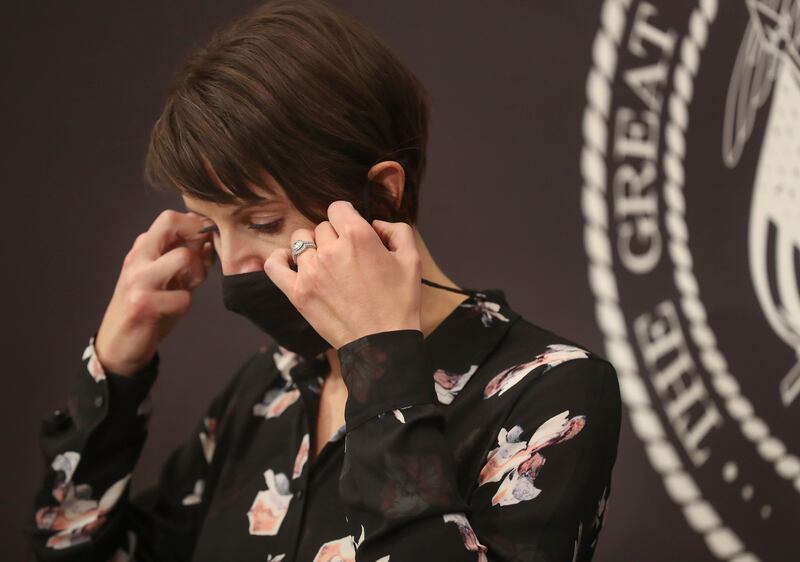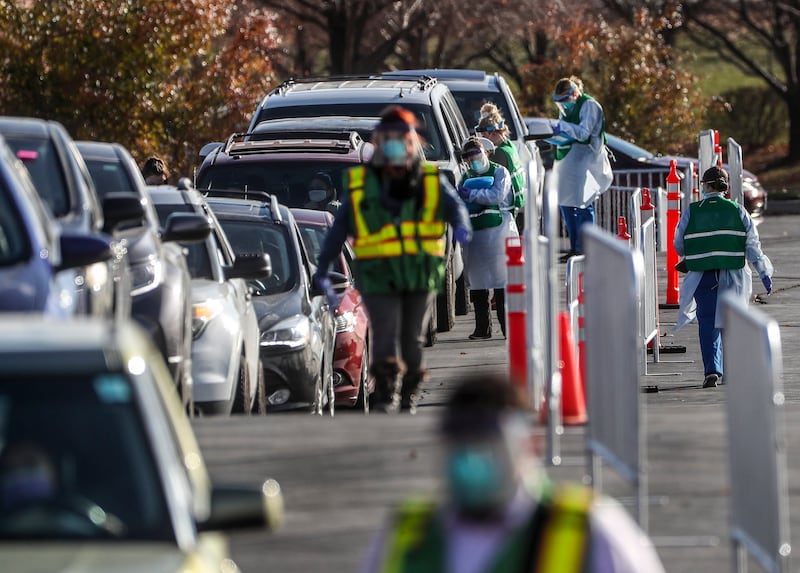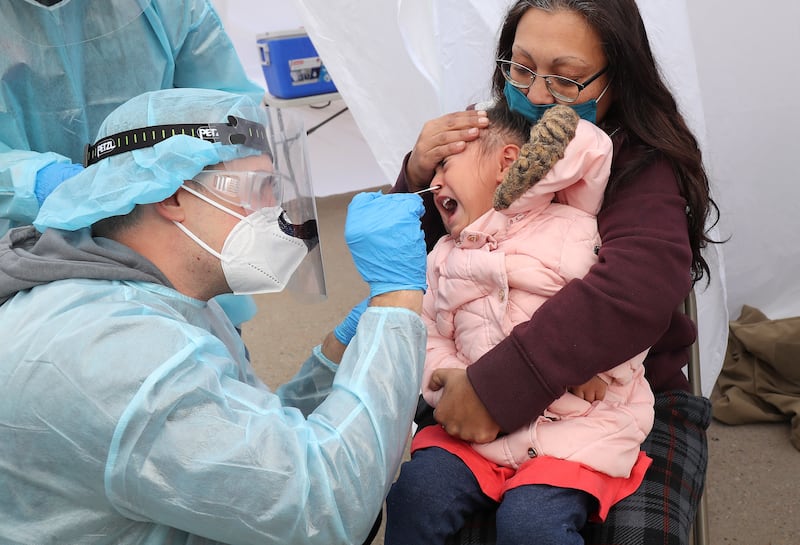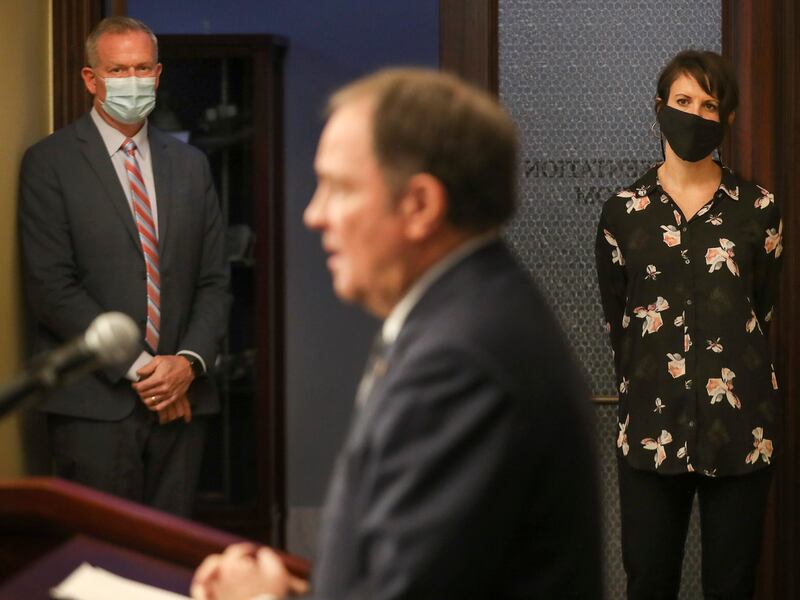SALT LAKE CITY — Two weeks after implementing a halt on casual social gatherings between members of separate households, Utah officials announced Monday that families can get together for Thanksgiving.
But they urged people to keep those gatherings small.
“We still are in challenging times. I’m sure that’s not a surprise to anybody as we see the case counts kind of leveling off a little bit now, but still way too high,” Gov. Gary Herbert said during a news conference Monday.
Utah health officials reported 2,244 new COVID-19 cases on Monday out of 7,462 people tested, with a 30.1% positive rate, as well as four additional deaths. The rolling seven-day average for new cases is 3,349 per day, and the average positive test rate is 23.6%.
Currently, 545 patients are hospitalized with COVID-19 in Utah, which is 11 fewer than were hospitalized on Sunday, the Utah Department of Health reported. Intensive care units throughout the state are 90.8% full, and referral ICUs that can treat the most serious patients are 94.3% full.
The two-week order halting casual social gatherings expires at midnight on Monday. The state’s transmission index will then return, placing counties under restriction levels based on COVID-19 transmission in their areas, said Rich Saunders, executive director of the Utah Department of Health.
Saunders said 26 of Utah’s 29 counties will be placed in the high transmission category. Daggett, Piute and Rich counties will be in the low transmission category. The transmission index previously limited the number of attendees that could gather for casual social events in households in each county, but will not do so again, Saunders said.

‘We’re asking people to voluntarily comply’
Herbert and Saunders both asked residents to keep gatherings small, wear masks even among family and friends, physically distance when possible and avoid potluck-style dinners.
“We’re trying not to prescribe how many people should be in your individual home. We want to leave that to your discretion,” Saunders said. “As for social gatherings, we still recommend gathering only with those of your same household. That is the safest way.”
While the halt on gatherings is set to expire, the state will continue to require universal mask-wearing indoors in public places and outdoors when physical distancing isn’t feasible, Herbert said.
Herbert’s decision to remove limits on social gatherings outside individual households came after tense closed-door meetings with legislators last week, during which some GOP House lawmakers complained about government mandates — particularly regarding restrictions over what Utahns are able to do in the privacy of their own homes.
When pressed by reporters whether the state has a plan should the high transmission rate and strain on hospitals continue, Herbert said the state does have “a plan in place. We anticipate it’s going to work. We believe people will in fact follow the recommendations we’re giving. Can that be modified? Absolutely.”
He also maintained that Utah is “battling like every other state” but also “doing better than almost every other state.”
“It doesn’t mean we’re where we want to be, but it doesn’t mean we need to give up hope,” Herbert said.
When asked why the casual social gathering restriction was lifted just before Thanksgiving even as hospital leaders say their systems are already getting overwhelmed, Herbert said: “We mentioned two weeks ago when we put the order in place, that we’re going to put a pause in place for two weeks and we’d lift it, which we’ve done and are doing.
“We think it’s a bit of a stretch to say to the people of Utah and our citizens: ‘We’re going to tell you what we can do in the walls of your home.’ That’s a challenge of government overreach. ... It doesn’t mean the risk has been any less over the last two weeks, and we’re asking people to voluntarily comply with good protocol,” he said.
The governor called the impending vaccine distributions “daylight at the end of the tunnel.” Within the next two to three weeks, the state will see its “first opportunities” to administer vaccines. In the spring around March or April, the vaccine could become available to the general population, Herbert noted.
Even as the state receives the vaccine, however, residents will need to continue following health protocols through at least next summer, Herbert said.
The public health order put in place two weeks ago also halted most extracurricular activities.
Beginning Nov. 30, all participants in high school extracurricular activities, including coaches, trainers and staff, will be required to get tested every other week. Those who receive a positive test won’t be able to participate in the activity until their isolation period ends, Saunders said.
Participants in club sports, dance studios, gymnastics gyms and volleyball gyms will be required to get checked for symptoms and exposure before each in-person activity including practices, according to Saunders.
Salt Lake mayor disagrees with changes
In a statement, Salt Lake City Mayor Erin Mendenhall criticized the “loosening” of restrictions ahead of the holiday.
“With new case counts breaking records weekly, daily deaths increasing, and no downward trend in sight, the governor’s loosening of the public health order today is the opposite of what state leadership should be doing right now,” Mendenhall said.
“Data-driven decision making means using the best available information to acutely address the source of the issue, and in Salt Lake County, the majority of case spread is within households. This announcement by the state to relax restrictions exactly where we know the most spread of COVID is happening, is counter to good logic and the data we have.”
She said the new order indicates to families that it’s now safer to gather than it was two weeks ago “when the data shows it absolutely is not.”
“I call on the state Legislature and the governor to take bold action to protect our health by making data-driven policy decisions, not succumb to the fatigue of this pandemic for the sake of a holiday,” Mendenhall said.

COVID-19 testing
Utah also continues ramping up its testing abilities. Anyone who wants a coronavirus test can get one by visiting testutah.com — including those who don’t have symptoms and haven’t come into contact with a case, said Dr. Angela Dunn, epidemiologist with the Utah Department of Health.
The largest lab in Utah processing COVID-19 tests, ARUP Laboratories, announced Monday it has created one of the first tests to identify COVID-19, influenza or respiratory syncytial virus in those with coronavirus symptoms.
“We are proud to offer this test, which is one of the first available to test for all four viruses,” Adam Barker, director of ARUP’s COVID-19 Rapid Response Laboratory, said in a statement.
“This single test is a simple, accurate way to determine which virus is the cause of illness as the flu and RSV seasons get underway amid the COVID-19 pandemic,” he said.
The tests can be ordered by physicians in Utah and across the U.S. beginning Monday.
The test identifies and differentiates between ribonucleic acid from SARS-CoV-2, along with the influenza A and B viruses and RSV, ARUP officials said, although it does not differentiate between the two common flu viruses. The test can be performed on samples collected through a deep nasal swab, or from the back of the throat and the front of both nostrils, officials said.
“The challenge clinicians face as we enter flu season is unparalleled even if flu and RSV activity remain low,” said Dr. Sherrie L. Perkins, ARUP CEO. “We’re pleased that this combination test will help them provide the best patient care possible as the pandemic persists.”

Four more deaths reported
The four new deaths reported Monday include: a Salt Lake County man older than 85, who was hospitalized when he died; a Salt Lake County woman between 45 and 64; a Washington County man between 65 and 84, who was a long-term care resident; and a Washington County man between 65 and 84, who was hospitalized when he died.
To date, 179,420 cases have been confirmed out of 1,352,407 people tested in Utah, with a 13.3% positive rate. Hospitalizations since the outbreak began now total 7,532.


